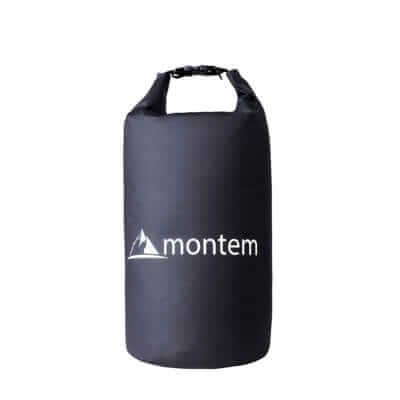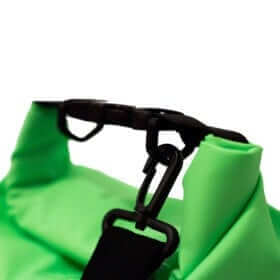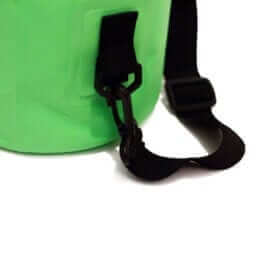Choosing the Best Dry Bags and Kayak Bags

Whether your adventures involve whitewater, helmets and a white-knuckled grip on your paddle, or a rod, reel, and stringer full of fish, kayak enthusiasts of all stripes require a couple of good dry bags. Dry bags (also known by some as kayak bags) are designed to keep your gear organized, protected and – most importantly – dry, no matter how wet and wild your outing becomes. However, not all
dry bags are built equally. Some live up to the expectations of outdoorsmen and outdoorswomen, performing admirably in even the most challenging conditions; while others quickly allow water to penetrate the bag. This not only defeats the whole purpose of the bag, it represents a waste of your hard-earned money. Accordingly, you’ll want to be sure to think about your choice carefully and scrutinize its characteristics before you click that “buy now” button. We’ve put together some of the most important characteristics for you to consider below. Just remember to take your time, and select the best dry bag for your needs.
Shop Montem’s Selection of Dry Bags
shop now
Sizes
There aren’t really any universal sizes used by the various manufacturers of dry bags, but most bags fall into one of three basic size categories: small, medium and large. However, some people use different names to refer to various sizes. For example, small bags are often called “cell phone” dry bags or “personal item” dry bags.
-
Small Bags – Small bags are ideal for things like your cell phone and wallet, as well as things you will need while you are out in the wilderness. For example, you may want to use one for a first aid kit, your flashlight or your water purifier. It is often advantageous to purchase several small bags, as this will help you organize your gear more effectively. Additionally, small dry bags are often used to protect high-value items such as trekking poles, as the small dry bag can be placed inside a medium- or large-sized dry bag.
-
Medium Bags – Medium bags are good for things like camping stoves, hiking boots, hiking backpacks, and larger tools. Additionally, they often make fantastic pillows if stuffed with clothing or other soft material. Some like to use medium-sized bags to keep food safe overnight (by suspending the bag out of bear-grasping reach). While this is an acceptable use, it is important to avoid using very thin dry bags for this kind of purpose.
-
Large Bags – Large dry bags are ideal for sleeping bags, camping blankets, and clothing. However, you can also stuff them full of smaller dry bags to provide another layer of protection for your gear. For example, if you need to take a laptop on your journey, it is wise to use more than one dry bag to protect the item. You can also use a large dry bag to protect your Nordic walking poles.
Materials
Although manufacturers are continually designing new materials and improving on old ones, most modern dry bags are made of one of two different materials: nylon and vinyl.
-
Nylon — Most modern dry bags are made from nylon. “Off-the-shelf” nylon isn’t a waterproof material, so it is usually coated with a water-repelling coating before being used to construct a dry bag. Silicone is one of the most common coating agents, although some are simply laminated with a thin plastic. Nylon is available in varying thread-counts, with higher thread counts representing superior quality.
-
Vinyl — Vinyl is usually used in lower-priced bags, but some high-quality small bags are made from vinyl. Vinyl is also used in bags that feature clear “windows.” One important benefit of vinyl bags is that it is usually easy to patch them if they should tear.
Closures
Dry bags feature a number of different closure types for keeping the water out of the bag. Many of the best bags actually feature more than one type of closure, for increased protection. Each style offers its own pros and cons.
-
Zipper – Metal zippers are used to close some dry bags. While zippers provide a great way to close up a dry bag, zippers frequently seem to break at the worst possible time. Unlike drawstring or roll-down closure styles, bags with zippers become largely useless once the zipper breaks. Additionally, zippers require lubrication and frequent attention to work properly.
-
Drawstring – Drawstring closures are typically used in conjunction with a roll-down or Velcro closure. Drawstrings are fairly easy to use, and at least theoretically repairable if they break, which many outdoor enthusiasts value.
-
Roll-Down – After filling one of these bags with your gear and equipment, you can roll down the top to help squeeze out the air and compress your gear a bit. There is usually a buckle or Velcro strip that keeps the bag top rolled up and watertight.
-
Velcro – Many dry bags feature a Velcro closure to provide an additional layer of water protection. Velcro is a great material for this application, as it is strong, secure and functional in both wet and dry conditions.



Shop Montem’s Selection of Dry Bags
shop now
Characteristics of Good Dry Bags
Not all dry bags are designed to do the same things, so there is a reasonable amount of variation among the different products on the market. However, most quality dry bags should feature the following characteristics:
-
Of course, all good dry bags must protect their contents from water. If a dry bag is not watertight, it isn’t really a dry bag, is it? Most quality dry bags meet this requirement in spades, but poor quality, low-cost models often fail in this regard. Some such models fail because they are made of substandard materials, while others allow water to seep in through the seams. Stick to established brands and avoid budget-priced bags and you’ll avoid most of these kinds of problems.
-
Good dry bags are made of thick, durable materials. It won’t matter how watertight your dry bag is if it rips on the first rock that scrapes against it. Because they serve a high-stakes purpose with safety implications, dry bags must be durable enough to withstand the rigors of a hard life on the trail and in your yak. Look for bags made from thick materials and well-stitched seams.
-
Ideally, dry bags should be brightly colored. If you take a spill, you’ll immediately need to begin gathering your belongings and putting them back in the boat. Although this is a simple task in principle, it is often quite challenging in practice. You’ll have water in your eyes, nose, and mouth; your clothing will be soaking up water, chilling you and weighing you down; and you’ll be trying to avoid rocks and other obstacles while you do so. Brightly colored bags are often much easier to see in these circumstances, which will make it easier for you to get your belongings back into the boat.
-
Good dry bags allow you to see the contents at a glance. While most dry bags are opaque (and the best ones are brightly colored, as stated above), many feature a clear or transparent “window” that allows you to see the bag’s contents without having to open it up. This is not only convenient, but it can also help you find needed items quickly, should the need arise. The first time you end up unpacking all of your gear to find your granola bars or first aid kit, you’ll swear off opaque bags forever.
-
Good dry bags feature robust hardware. Any zippers, D-rings or clips on your dry bag must be well-built and sized appropriately for the application. Cheap dry bags often use low-quality rings, zippers and other types of hardware in an attempt to keep the price low, but in the end, you’ll regret choosing bags that cut corners in such manners. If your bag’s D-ring fails, you may end up chasing your dry bag for miles down the river, for example.
-
The best dry bags feature shoulder straps or lanyards. While your dry bags will spend most of their time sitting in your kayak, you’ll eventually have to lug them to the campsite or your vehicle. This will be much easier to accomplish if the bags have carrying straps. Large bags should have shoulder straps, while smaller bags (such as those designed to contain your cell phone, wallet and car keys) should feature a lanyard-style neck loop.
*** Good dry bags are worth their weight in gold (their filled weight, that is – they don’t weigh very much when they’re empty). They not only make outdoor adventures more fun and convenient, but they also help to keep you safe; wet clothing and bedding can make you miserable at best and hypothermic at worst. Just be sure to consider the characteristics of good bags that we’ve outlined above and selected a set of bags that make sense for your specific plans and needs. You’ll be glad you did.
Related Buyer Guides
 Whether your adventures involve whitewater, helmets and a white-knuckled grip on your paddle, or a rod, reel, and stringer full of fish, kayak enthusiasts of all stripes require a couple of good dry bags. Dry bags (also known by some as kayak bags) are designed to keep your gear organized, protected and – most importantly – dry, no matter how wet and wild your outing becomes. However, not all dry bags are built equally. Some live up to the expectations of outdoorsmen and outdoorswomen, performing admirably in even the most challenging conditions; while others quickly allow water to penetrate the bag. This not only defeats the whole purpose of the bag, it represents a waste of your hard-earned money. Accordingly, you’ll want to be sure to think about your choice carefully and scrutinize its characteristics before you click that “buy now” button. We’ve put together some of the most important characteristics for you to consider below. Just remember to take your time, and select the best dry bag for your needs.
Whether your adventures involve whitewater, helmets and a white-knuckled grip on your paddle, or a rod, reel, and stringer full of fish, kayak enthusiasts of all stripes require a couple of good dry bags. Dry bags (also known by some as kayak bags) are designed to keep your gear organized, protected and – most importantly – dry, no matter how wet and wild your outing becomes. However, not all dry bags are built equally. Some live up to the expectations of outdoorsmen and outdoorswomen, performing admirably in even the most challenging conditions; while others quickly allow water to penetrate the bag. This not only defeats the whole purpose of the bag, it represents a waste of your hard-earned money. Accordingly, you’ll want to be sure to think about your choice carefully and scrutinize its characteristics before you click that “buy now” button. We’ve put together some of the most important characteristics for you to consider below. Just remember to take your time, and select the best dry bag for your needs.


